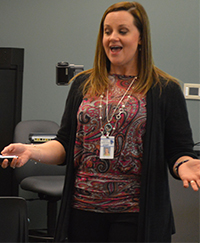If a child has green snot coming from his nose, he might be taken to a doctor, right? asked Karyll Russell, Sparta Middle School counselor.
But when a child is showing signs of anxiety, depression or other mental-health disorders, people aren’t always quick to respond, she said at a recent Youth Mental Health First Aid training session.
| Five-Step Response
When something seems off with a student who may seem depressed, angry, anxious or showing other signs of distress, those certified in Youth Mental Health First Aid are trained to respond using ALGEE, a five-step plan that stands for:
|
Russell and Steve Dieleman, Kent ISD health education consultant, provided educators and counselors with skills to respond appropriately when students face mental distress.
“We approach this from a behavioral observational point of view, not of trying to make diagnoses,” Dieleman said, noting that it’s key to build awareness of “red flags,” signs that a student is struggling.
Instructors introduced participants to mental-health disorders in contrast with normal adolescent behavior. Course topics included anxiety, depression, substance use, disorders in which psychosis may occur. Participants were trained on a five-step action plan to help young people in distress.
The workshop, a collaboration between Kent ISD, county community mental health agency Network 180, and The Mental Health Foundation, was funded through Project AWARE, a grant that aims to develop ways for schools to address mental-health needs. Kent ISD received the grant from the Michigan Department of Education and Michigan Department of Health and Human Services.
Working Directly with Schools
The five-year grant will also fund work with Godfrey-Lee Public Schools, Grandville Public Schools and Sparta Areas Schools to create customized services to address individual community needs, better directing students to the help they need.
“One aspect of the entire initiative is to improve the integration of mental-health services in schools,” Dieleman said.

Russell, a 14-year school counselor, said she became trained as an instructor to help the school community respond appropriately to students’ mental-health problems.
“I have noticed a greater and greater need for an understanding about mental health and a need to reduce the stigma surrounding mental health,” she said. “I feel like schools are a wonderful venue to do that because we are a conduit to the community. I wanted to be part of making that happen.”
If people are trained to respond, students will have someone to turn to, Russell said.
“When people feel like they are not alone, when there’s an understanding about what they are going through, when they feel connected, they are more likely to get help from a professional.”
It’s also about changing perceptions of mental illness so people aren’t afraid or ashamed to seek help, she said.
One in five Americans suffer from a diagnosable mental illness each year. Mental illness is the leading cause of disability in the U.S., but 80 percent of Americans with treatable mental disorders do not receive proper diagnosis and an effective treatment, according to information from the training guide, “Youth Mental Health First Aid USA For Adults Assisting Young People“.
Training participant Kellie Murray, a MySchool@Kent instructor, said many students in the online high-school program located at Kent ISD have trouble being in social settings.

“It helps to work with them and create a safe place for them at school,” Murray said.
Cedar Springs Middle School KSSN coordinator Jodi West said she is the point of triage for many students facing mental health crises, especially anxiety, depression, self-harm and eating disorders. “I wanted to make sure I had all the information that’s current and new so I can support them.”
CONNECT
Youth Mental Health First Aid









